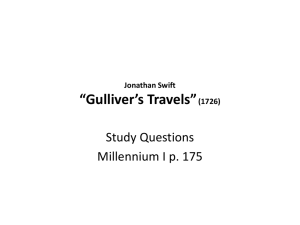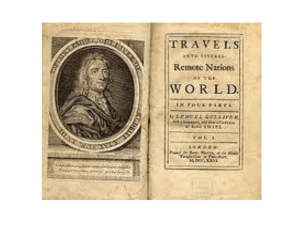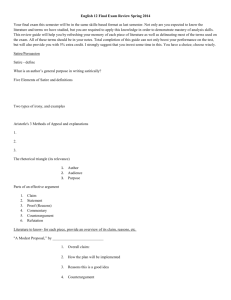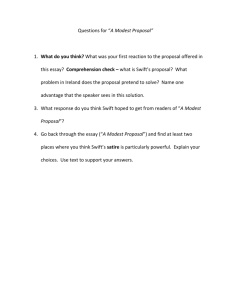Gulliver's Travels Article 4
advertisement
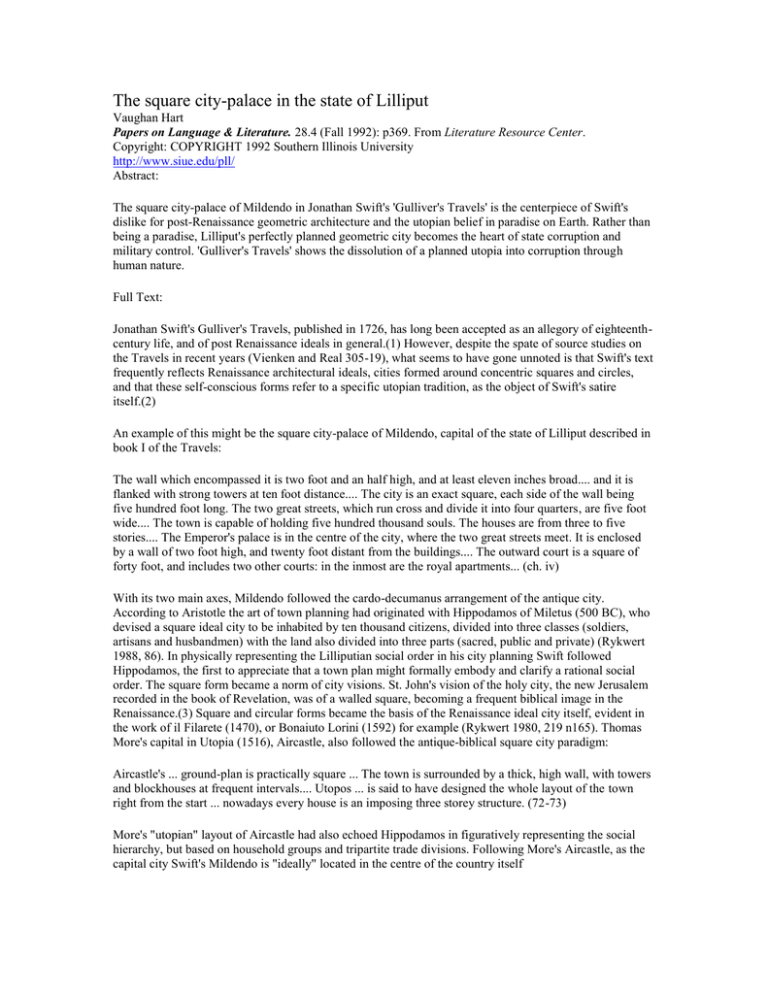
The square city-palace in the state of Lilliput Vaughan Hart Papers on Language & Literature. 28.4 (Fall 1992): p369. From Literature Resource Center. Copyright: COPYRIGHT 1992 Southern Illinois University http://www.siue.edu/pll/ Abstract: The square city-palace of Mildendo in Jonathan Swift's 'Gulliver's Travels' is the centerpiece of Swift's dislike for post-Renaissance geometric architecture and the utopian belief in paradise on Earth. Rather than being a paradise, Lilliput's perfectly planned geometric city becomes the heart of state corruption and military control. 'Gulliver's Travels' shows the dissolution of a planned utopia into corruption through human nature. Full Text: Jonathan Swift's Gulliver's Travels, published in 1726, has long been accepted as an allegory of eighteenthcentury life, and of post Renaissance ideals in general.(1) However, despite the spate of source studies on the Travels in recent years (Vienken and Real 305-19), what seems to have gone unnoted is that Swift's text frequently reflects Renaissance architectural ideals, cities formed around concentric squares and circles, and that these self-conscious forms refer to a specific utopian tradition, as the object of Swift's satire itself.(2) An example of this might be the square city-palace of Mildendo, capital of the state of Lilliput described in book I of the Travels: The wall which encompassed it is two foot and an half high, and at least eleven inches broad.... and it is flanked with strong towers at ten foot distance.... The city is an exact square, each side of the wall being five hundred foot long. The two great streets, which run cross and divide it into four quarters, are five foot wide.... The town is capable of holding five hundred thousand souls. The houses are from three to five stories.... The Emperor's palace is in the centre of the city, where the two great streets meet. It is enclosed by a wall of two foot high, and twenty foot distant from the buildings.... The outward court is a square of forty foot, and includes two other courts: in the inmost are the royal apartments... (ch. iv) With its two main axes, Mildendo followed the cardo-decumanus arrangement of the antique city. According to Aristotle the art of town planning had originated with Hippodamos of Miletus (500 BC), who devised a square ideal city to be inhabited by ten thousand citizens, divided into three classes (soldiers, artisans and husbandmen) with the land also divided into three parts (sacred, public and private) (Rykwert 1988, 86). In physically representing the Lilliputian social order in his city planning Swift followed Hippodamos, the first to appreciate that a town plan might formally embody and clarify a rational social order. The square form became a norm of city visions. St. John's vision of the holy city, the new Jerusalem recorded in the book of Revelation, was of a walled square, becoming a frequent biblical image in the Renaissance.(3) Square and circular forms became the basis of the Renaissance ideal city itself, evident in the work of il Filarete (1470), or Bonaiuto Lorini (1592) for example (Rykwert 1980, 219 n165). Thomas More's capital in Utopia (1516), Aircastle, also followed the antique-biblical square city paradigm: Aircastle's ... ground-plan is practically square ... The town is surrounded by a thick, high wall, with towers and blockhouses at frequent intervals.... Utopos ... is said to have designed the whole layout of the town right from the start ... nowadays every house is an imposing three storey structure. (72-73) More's "utopian" layout of Aircastle had also echoed Hippodamos in figuratively representing the social hierarchy, but based on household groups and tripartite trade divisions. Following More's Aircastle, as the capital city Swift's Mildendo is "ideally" located in the centre of the country itself However, Swift uses this centrally located square city paradigm, in the utopian tradition, as a framework for state corruption and military control. Lilliputian society itself had been founded on qualities Swift held as ideal(4), but over time this original constitution has evidently become abused. Whilst the city's planning was intended to celebrate this constitutional order, its corruption has in fact been aided by the central position of the palace in the city. Themes of royal absolutism echo throughout book I. The Emperor of Lilliput possessed absolute arbitrary power and through his title claimed a world monarchy: "most mighty Emperor of Lilliput, Delight and Terror of the Universe ... Monarch of all Monarches, ... whose feet press down to the centre, and whose head strikes against the sun" (ch. iii). Evidently like the French monarchy the ruler of Lilliput aspired to the title of "Sun King." Over time the state of Lilliput has turned the square ideal into the most perfect expression of royal absolutism, the city-palace itself becoming implicated in Gulliver's gradual disillusionment in the ideal of the modern state in book I. This is obviously part of Swift's overall aim, the general ridicule of post-Renaissance pretensions towards creating an earthly paradise, after the loss of Eden and the destruction of antiquity, and as such is bound up in the famous late seventeenth- and early eighteenth-century battle between the "Ancients" and "Moderns" (Levine 374-413). Swift's dislike of such centralized geometric planning, as a conceit of the "Moderns," had been satirized in the form of a spider's web in The Battle of the Books (1704), where: upon the highest corner of a large window, there dwelt a certain spider, swollen up to the first magnitude by the destruction of infinite numbers of flies, whose spoils lay scattered before the gates of his palace, like human bones before the cave of some giant. The avenues to his castle were guarded with turnpikes and palisades, all after the modern way of fortification. After you had passed several courts, you came to the centre, where you might behold the constable himself in his own lodgings, which had windows fronting to each avenue, and ports to sally out upon all occasions of prey or defence. (110-11) Here, through the spider's skill in "architecture and other mathematics," "Modern" architecture is presented by Swift as a branch of geometry. Like the "Modern" spider, the central position of the Lilliputian king has facilitated absolute control over the whole city and empire - a position once occupied by the temple in ancient, cardo-decumanus towns. In the modern utopia," no higher order is evoked in the city's place of honor, for man, not God, is now housed in the centre with a consequent disruption in what for Swift had been the ancient balance between people, ruler and creator. Ironically, in Mildendo a wall now makes the modern court inaccessible and protected from the very people the king and queen once served and protected. The remoteness of modern courts and kings from their people was one of Swift's constant themes, echoing in such as It cannot Rain but it Pours: or, London Shower'd with Rarities (1726) and The Metamorphosis of the Town, or a View of the Present Fashions (1730). In the Travels the theme of duty of kingship would reappear in book II through the paternalist model offered by the king of Brobdingnag and his "domestic," informally arranged court, in contrast to the physical and mental remoteness of the Laputan court, with its concentric city, in book III. The Lilliputian court itself is housed within a "Magnificent palace ... [with] the most splendid apartments that can be imagined" (ch. iv). Such "splendid" architecture becomes, by association, the paraphernalia of absolutism. The most obvious contemporary example of such remote, centrally arranged court architecture as a product of royal absolutism was Versailles. Indeed, Versailles' grandiose architecture is directly ridiculed later in the Travels, associated with the gruesomeness of an execution: "The veins and arteries spouted up such a prodigious quantity of blood, and so high in the air, that the great jet d'eau at Versailles was not equal for the time it lasted" (bk.II ch.v). In book I the physical proximity of Gulliver's accidental size is used to make such architecture seem ridiculous, for in Swift's world the enormous and "splendid" apartments of Versailles could also be simply reduced to nothing by accidental fate, a chance shipwreck of a giant. Swift plays like a child with physical scale to make the architecture of the court look small, an architectural "trick" often to be found in the "larger-than-life" scale of the theatre stage. The absolutist courts of Swift's day revelled in elaborate state rituals bordering on the theatrical (Rykwert 1980, 61). This artificiality echoes in Gulliver's early perception of Lilliput, noting that the square citycourt "looked like the painted scene of a city in a theatre" (ch. ii). Swift's rituals of the Lilliputian "puppet- court" have been shown to rely for their effect on tricks reminiscent to the contemporary reader of the popular London fairground.(5) Of course, a world of giants and little people has its own primary circus quality. In this way the Lilliputian state's pretensions towards a permanent architectural order based on Renaissance utopian and later absolutist geometric ideals, outer royal park, square walled city and core palace, are reduced by tricks of scale and accidental fate to a framework for a mere circus puppet-show. (1) See Eddy 14-15; Firth notes: "A critic who seeks to explain the political significance of |Gulliver's Travels' may be guilty of too much ingenuity, but he cannot fairly be charged with exaggerated curiosity. He is searching for a secret which Swift tells us is hidden there, and endeavouring to solve riddles which were intended to exercise his wits" (1). (2) Gulliver's large house in book I satirized Blenheim and small house in book II Vanbrugh's house in Whitehall, see Hart 1992, 26-32; the floating circular city of Laputa in book Ill satirized Tommaso Campancila's City of the Sun (1623), see Hart 1991, 111-14. (3) Illustrated by Lucas Cranach in Martin Luther's German Bible of 1534, for example, and by Alonso Cano in his "Vision of St. John" of 1635-37. (4) See Lock; Lilliput possessed laws "more disposed to reward than to punish," believing "that Providence never intended to make the management of public affairs a mystery" (ch. vi) - which is one of Swift's settled themes; also following Swift, Lilliputian "opinion is, that parents are the last of all others to be trusted with the education of their own children" (ch. vi). (5) See Rogers 15971; Swift satirized the modern city's liking for such weird shows in the same year as the publication of the Travels through his portrait of "Peter the Wild Boy" in London Shower'd with Rarities, where, like Gulliver, the wild natural man is introduced into an "unnatural" court. Works Cited Eddy, William. Gulliver's Travels, a Critical Study. Princeton: Princeton UP 1923. New York, 1963. Firth, Charles. The Political Significance of Gulliver's Travels. London, 1920. Oxford, 1968. Hart, Vaughan. "Gulliver's Travels into the City of the Sun." Swift Studies 6 (1991): 111-14. _____ . "Vanbrugh's Travels." History Today 42 (July 1992): 26-32. Levine, Joseph. The Battle of the Books. Ithica: Cornell UP, 1991. Lock, Frederick. The Politics of Gulliver's Travels. Oxford: Oxford UP, 1980. More, Thomas. Utopia. Louvain, 1516. Harmondsworth, 1961. Rogers, John. "Swift, Walpole and the Rope Dancers." Papers on Language and Literature 8 (1972): 159-71. Rykwert, Joseph. The First Moderns. London, 1980. _____ . The Idea of the Town. Princeton, 1988. Swift, Jonathan. The Battle of the Books. London, 1704. Oxford: Oxford UP 1986. _____. Gulliver's Travels. London, 1726. Harmondsworth, 1967. _____. It cannot Rain but it Pours: or, London Shower'd with Rarities. London, 1726. _____. The Metamorphosis of the Town, or a View of the Present Fashions. London, 1730. Vienken, Heinz and Hermann Real. "|Ex Libris' J.S.: Annotating Swift." Proceedings of the First Munster Symposium on Jonathan Swift, Munchen, 1985:30519. Source Citation (MLA 7th Edition) Hart, Vaughan. "The square city-palace in the state of Lilliput." Papers on Language & Literature 28.4 (1992): 369+. Literature Resource Center. Web. 20 Apr. 2016. URL http://ezproxy.fhda.edu:2128/ps/i.do?id=GALE%7CA13638931&v=2.1&u=ccl_deanza&it=r&p=LitRC&s w=w&asid=c674e467cf3655e5840a38d4ac1801bd Gale Document Number: GALE|A13638931
